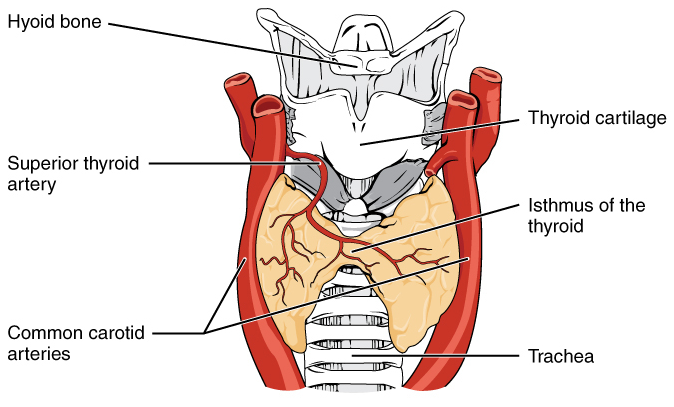Thyroid gland
The thyroid gland is a small gland located in the front of the neck, shaped like a butterfly. It is an important component of the endocrine system and plays a crucial role in regulating various functions in the body by producing and releasing specific hormones.
One of the primary functions of the thyroid gland is to control the metabolic rate of the body. Metabolism refers to the biochemical processes that occur within an organism to convert food into energy. The thyroid gland produces hormones called thyroxine (T4) and triiodothyronine (T3), which play a key role in regulating metabolism.
 |
| Thyroid Gland |
These thyroid hormones are released into the bloodstream and affect the functioning of cells throughout the body. They help regulate the rate at which cells utilize oxygen and nutrients to produce energy. By influencing the metabolic rate, the thyroid hormones impact a wide range of bodily functions, including heart rate, body temperature, digestion, growth, and development.
When the thyroid gland is underactive, it produces insufficient amounts of thyroid hormones, resulting in a condition known as hypothyroidism. This can lead to a slower metabolism, causing symptoms such as fatigue, weight gain, cold intolerance, and depression.
The regulation of metabolism by the thyroid gland is a complex process involving feedback mechanisms and interactions with other glands and hormones in the body. It is essential for maintaining overall health and ensuring the proper functioning of various bodily systems.
What is the endocrine system?
Yes, that's correct! The endocrine system is a sophisticated interconnected web of glands responsible for the production and release of hormones. Hormones are chemical messengers that play a vital role in coordinating and regulating various functions and processes in the body.
Glands are organs or tissues that specialize in the production and release of specific substances. In the case of endocrine glands, they release hormones directly into the bloodstream, allowing the hormones to travel throughout the body and reach target organs or tissues.
Hormones act as signals or messengers, relaying information to different parts of the body. They play a crucial role in maintaining homeostasis, which is the body's internal balance and stability. Hormones regulate processes such as metabolism, growth and development, reproduction, stress response, sleep-wake cycles, and many others.
The endocrine system consists of several major glands, including the hypothalamus, pituitary gland, thyroid gland, parathyroid glands, adrenal glands, pancreas, ovaries (in females), and testes (in males). Each gland produces specific hormones that have unique functions and target specific organs or tissues.
When hormone levels are imbalanced or there is a dysfunction in the endocrine system, it can lead to various health conditions and disorders. For example, diabetes is a disorder characterized by inadequate insulin production or utilization, which affects blood sugar regulation.
Overall, the endocrine system and its hormones play a vital role in maintaining the proper functioning and coordination of various processes in the body, ensuring optimal health and well-being.
The following organs and glands make up your endocrine system:
- Adrenal glands.
- Pineal gland.
- Hypothalamus.
- Pituitary gland.
- Thyroid.
- Pineal gland.
- Pancreas.
- Ovaries.
- Testes.
Thyroid gland: Hormones and functions
Follicular cell:
- these cells are most prevalent cell.
- They secretes thyroid hormones (T3 and T4)
Parafollicular cell:
- cluster of parafollicular cells are found between follicluar cells.
- they are larger than follicular cell.
- parafollicular cells synthesize and secretes calcitonin.
Location: in neck region on either side of trachea
Size: Each lobe is 4-6 cm long, and 1.5 cm thick
Hormones of Thyroid gland
1. Thyroxine (Tri-Iodothyronine and tetra-Iodothyronine)
- Follicular cells in the thyroid gland secrete thyroxine, also known as T4, which is a hormone composed of four atoms of iodine. Additionally, these cells also secrete triiodothyronine (T3), a hormone that contains only three atoms of iodine.
- T3 and T4 collectively known as Thyroid hormone
- An increase in basal metabolic rate leads to an elevation in oxygen consumption in most tissues, excluding the lungs, brain, testes, and retina.
- Essential for growth of skeletal in children. Thyroxine is regulated by TSH from Pituitary gland.
- Increase carbohydrate metabolism, promote gluconeogenesis
- Effect on lipid metabolism
- Stimulate NA-K ATPase.
- Influence water and electrolyte balance.
- It is regulated by TSH
- At first T4 is synthesized which is converted to T3. T3 is five times more potent than T4.
- Deficiency of thyroxine: Goiter, Hypothyroidism
- Excess of thyroxine: thyrotoxicosis, hyperthyroidism.
2. Calcitonin
- Parafollicular cells secretes calcitonin. Calccitonin is a polypeptide hormone.
- Secretion of calcitonin is regulated by concentration of calcium in blood but not by feed back mechanism of Pituitary gland.
Functions of calcitonin:
- It reduces the level of calcium in the blood, acting as an antagonist to parathyroid hormone.
- It directly affects osteoclasts, inhibiting bone remodeling and increasing the reabsorption of calcium.
- It increases the movement of Ca++ from blood to bone
Disorder of thyroid gland
1. Cretinism:
- deficiency of thyroxine in children
- pot belly, pigeon chest in children with physical and mental retardness
- dwarfism (cretins)
2. Myxedema:
- deficiency of thyroxine in adults
- puffiness of skin
- mental retardness
- It leads to a decrease in body temperature, basal metabolic rate (BMR), and blood pressure.
3. Simple goitre:
- deficiency of iodine in diet and hence deficiency of thyroxine
- swelling of thyroid gland, visible in neck region
- low BMR. low Blood pressure and heart rate
- fatigue and sluggishness











0 Comments